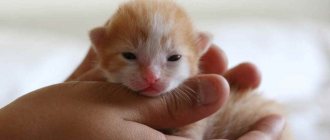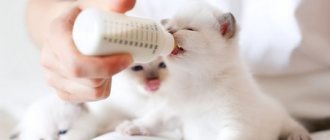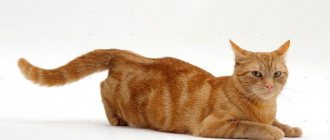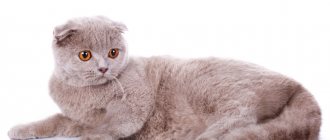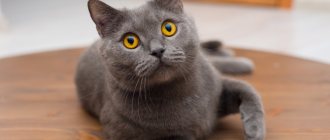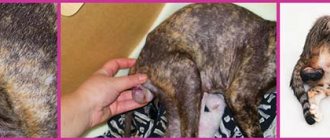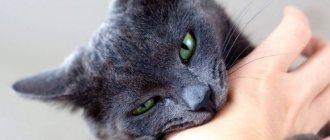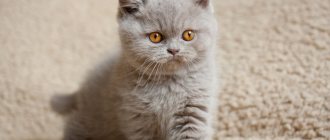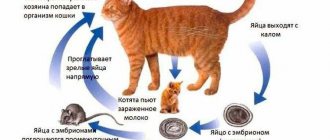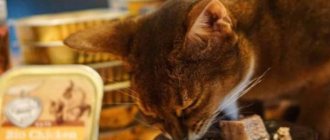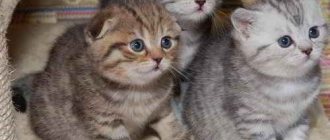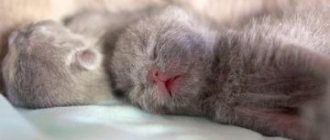If a person is interested in purchasing newborn fold kittens, then it is important to find out information on how to correctly determine whether a Scottish fold kitten is lop-eared. After birth, it is difficult to distinguish whether a cat is a fold cat or not. Unscrupulous breeders try to sell straight-eared pets to unknowing buyers for a high price. To avoid being deceived, it is recommended to study the main differences and recommendations for choosing a cat.
Appearance of a Scottish Fold cat
The history of participation of Scottish Fold cats in exhibitions is not so long.
Today, there is one general breed standard that all Scottish Folds must meet. In addition, at major competitions, panels of judges use three types of official standards to evaluate animals: WCF, CFA and TICA. The appearance of a Scottish Fold cat must fully comply with all the requirements of the general breed standard.
Head
Scottish fold cat face
Round, with a strong chin, thick round cheeks and a high forehead. The chin is massive and strong. For adult cats, sagging cheeks are allowed. The nose of a Scottish Fold cat should be wide and short.
Ears
Small to medium in size, with slightly pointed tips. They are located widely on the head. Folds forward and down. A special requirement is that when folded and pressed, they must fit into the contour of the head without protruding beyond its boundaries. There are three types of lop ears:
- single (only the ends are bent);
- double (the entire auricle is bent, the gap between the ears and the head is visible);
- triple (fully pressed, there is a visual effect of the absence of ears).
Eyes
Scottish kitten
Widely spaced and round, large in size. An important point is that the eye color must match the overall color of the animal.
Neck
Scottish Folds are characterized by a fairly short, muscular neck.
Torso and limbs
Scottish Fold cats have a medium-sized body, muscular and strong. Well-developed shoulders and chest are clearly defined. Limbs of medium length with developed muscles. The paws are small and round.
Tail
Size – from medium to long. At the base it is quite wide, gradually tapering to a rounded tip. Movable and flexible.
Wool
The cover is dense, elastic and thick. Due to its high density, it does not adhere to the animal’s body, and it looks fluffy.
Color
The Scottish Fold can have a wide variety of coat tones. The breed standard does not make any specific requirements in this matter. But when judges give marks at competitions, they will necessarily take into account the correspondence of the shade of six to the color of the eyes, nose and paw pads, for example:
- color six white. Eye color – golden or blue. Nose and paw pads are pink;
- the fur is pure black. The eyes are only golden. Nose – black, paw pads – gray or black;
- For a smoky-black color, paw pads that are exclusively black in tone are considered harmonious. The color of the eyes and nose is the same as for the pure black coat.
The variety of colors is one of the features that distinguishes Scottish Folds from other cat breeds, and certain requirements for compliance with the general range are imposed on each representative of the breed.
Scottish Folds are medium-sized cats. The weight of females is from 3.5 to 4.5 kg, males are larger - up to 6 kilograms.
What documents should there be?
The purebred Scottish Fold cat, as well as its health parameters, must be confirmed by official documents:
- metric or pedigree;
- certificate of registration (for American organizations);
- purchase agreement;
- veterinary passport;
- transfer to own a cat (in rare cases);
- veterinary certificate No. 1 (for imported animals).
Important! A serious nursery will not sell cheap kittens without documents and expensive ones with documents. From a responsible breeder, all animals have documents issued simultaneously for the litter, which is registered as a whole.
If you receive a metric in your hands, the pedigree is no longer needed, and vice versa. But the breeder is obliged to hand over one of these main papers, regardless of the purpose of acquiring the “Scot” - for breeding or castration.
Documentation of the litter in the breed club is strictly regulated, but is inexpensive. All papers received from the breeder minimize your potential risks: you will always return the animal and the money spent if it is found to have congenital anomalies.
Metrics
This is a birth certificate issued after the animal is registered in the club system. The following must be included in the document (where the emblem of the system to which the “Scotsman” is assigned) is affixed:
- Name;
- date of birth;
- gender and breed;
- color;
- names/colors of manufacturers;
- breeder's name and other information.
The European certificate is affixed with the seal of the club and the signature of the responsible person who activated the litter: this is necessary to exchange the metric for the pedigree. In American systems, a slip (metric) is used to register a kitten and obtain a pedigree through the central office.
Pedigree
This includes the kitten’s ancestors (up to 3–5 generations) with their names, colors and pedigree numbers . This document contains the name of the nursery and club, the association's emblem, information about the kitten, as well as the names of the breeder and owner.
Attention! The “owner” column should contain your name, not the name of the breeder. To do this, obtain a pedigree yourself or agree with the breeder to prepare it in advance.
European pedigrees are provided with a number, the seal of the club and the signature of its leader, American pedigrees - only with a number . Pedigree in the USA is informative, and pedigree is confirmed by registering the kitten (and its litter) in the system according to its rules.
In European associations, you may be given a pedigree without a number or marked “pet”, or not at all if you adopted a “Scot” for castration. If you want to draw up a pedigree yourself (provided you have a metric), do it before the pet turns one year old. If you are not going to breed purebred cats, you won't need a pedigree.
Veterinary passport
Information such as:
- name and gender of the kitten;
- breed and date of birth;
- vaccination records (with a veterinary clinic stamp, a special sticker and a doctor’s signature);
- owner/breeder's name.
Despite the fact that a veterinary passport is issued to every purebred animal, it cannot serve as confirmation of the breed: the veterinary passport is filled out by the breeder or doctor, and clubs and felinological associations are responsible for the purity of the breed.
Other documents
All other documents (certificate of registration of the kitten in the system, transfer of ownership, veterinary certificate in form No. 1) are optional, that is, optional. An exception is a purchase and sale agreement, which will protect your rights if an unscrupulous breeder sells you a cat that is known to be sick.
Important! A Scottish Fold cat without documents is not recognized as a purebred cat and is automatically excluded from breeding.
Return to content
Personality of the Scottish Fold cat
Oh yeah!
Continue Everyone is well aware of the statement that a dog becomes attached to its owner, and a cat becomes attached to a place. In the case of the Scottish fold, both theses will be absolutely relevant and true.
The starting point for understanding the character traits of the animal is the fact that from the very beginning of the breed, Scottish Fold cats were bred and kept exclusively in domestic conditions. Scottish Folds are typical homebodies who feel great even in city apartments, although periodic walks in the fresh air will in no way harm the pet.
When purchasing a Scottish fold cat, you should take into account that representatives of this breed are very affectionate and sensitive. They can be unsettled not only by rearranging the furniture in the house, which, by the way, cats of any breed do not like, but also by the long absence of the owner. Loneliness for the Scottish Fold is worse than physical pain. The animal may even become depressed. Kittens and young animals are especially vulnerable in this sense. The opportunity for constant positive communication with a person is simply necessary for them.
I'm quite comfortable
A calm, balanced, even somewhat phlegmatic character is inherent in almost all representatives of this breed. They are very affectionate and patient. Cases of aggressive behavior are so rare that many, seeing how the Scottish Fold refuses to enter into conflict, think that he is simply afraid. This is wrong. The Scot is a true gentleman (or lady), and prefers a secular solution to the problem - to ignore the ill-mannered bully, be it an animal or a person. If the Scottish Fold gets into a difficult situation, you can be sure that he will be able to stand up for himself.
The Scottish Fold cat is perfect for families with small children. The Scotsman will never let out his claws, trying to avoid intrusive advances from your child, but will prefer to retire in an aristocratic manner. Almost always he will find a common language with other pets, although with dogs and rodents some tension in relationships will be traced. Many are surprised to note that apparent passivity and ostentatious slowness in no way interfere with the sometimes very vivid manifestation of the hunting instinct. Appearances can be deceiving, and even a cat, whose favorite place is a sofa cushion or the owner’s lap, will never refuse to exercise in the “sports corner” that you build for it in the house.
Would you like some wine?
Another interesting character trait of the Scottish Fold is its practicality, which is surprising for animals. Although in this case we are not even talking about character traits, but about intelligence. A cat has never been considered a stupid animal anywhere, but all owners of folded cats note their amazing ability to differentiate information received from outside and use only that which will be beneficial to them and can be useful in life. It is difficult to explain the mechanism of such selectivity from the point of view of human logic, and it is not really necessary. Thanks to this feature, Scottish Folds are very well trained and raised; it is only important to find a common language with them.
By the way, about the language. The Scottish Fold is often called a cat without a voice. This is not entirely fair. It’s just that the sounds that these animals make really bear little resemblance to a cat’s meow and are somewhat creaky, but is this considered a disadvantage?
The Scots are graceful and beautiful, so they are rightfully considered the adornment of any home. They are very playful, especially young animals; adults are distinguished by sedateness, equanimity and aristocracy. And the ability to stand in a “column” or sleep on their back, and their touching “owl” face have made Scottish Folds the heroes of numerous photo shoots.
It doesn’t matter whether you live alone or you have a large happy family - the Scottish fold cat will always look harmonious in your home. Attention, a kind word and a desire to understand your pet are the main components of a long-term friendship.
Periodization of the kitten's life stages. The first stage - mom is nearby
Kittens grow up to 1 year, during which significant changes occur every month. At the same time, 2-2.5 years is the period when the body finally gets stronger and becomes an adult.
| Age | Image | Peculiarities | Recommendations |
| First week | Weight – 100 g. Body length – 9-12 cm. No hearing until the 4th day. Eyes don't open. Undercoat appears. The umbilical cord separates on the 3rd day | Food is mother's milk, which the baby senses through olfactory receptors and consumes naturally. Antibodies contained in cat milk help an unvaccinated kitten resist infections. Do not disturb the unity of the kitten and the cat, so as not to scare the baby | |
| Second week | Weight - 250 g. By the end of this period, the eyes open; at first, the eye color of all kittens is cloudy blue. Attempts to walk, crawl away from the mother by 30-50 cm. | Stroke the kitten gently. Do not cause aggression on the part of the mother cat, who is worried about the younger generation at their first manifestations of independence | |
| Third week | Weight – 300 – 350 g. Support on 4 legs. On days 15-17 they begin to see. Orientation in distances. First milk teeth. Scratching behind the ear. Interest in playing with people | Play with kittens without sudden movements. Do not leave small children and kittens unattended | |
| Fourth week | Weight – 450 g. Approximately 26 teeth | Organize worm prevention. Drink filtered water from shallow bowls. Provide the kitten with constant access to water | |
| Fifth week | The cat reduces the level of care for the baby. The kitten learns to wash itself. The fur becomes brightly colored | Stock up on age-appropriate liquid food. Include solid foods in your diet. Provide the kitten with constant access to food (100 grams of food is the norm). Do not allow your baby to eat from adult bowls. Organize a pet house |
Adding to the family: how to care for a mother and her newborns
In the first weeks after the birth of kittens, providing proper care is the key to healthy babies and cats. The list of necessary actions on the part of the owners is as follows:
Provide a warm, dry box for mother and kittens. Place a white sheet over it to help track your cat's waste. Provide your cat with a balanced diet. Organize constant access to water for babies and mothers. Do not try to separate the kittens from the cat.
The last point determines the development of the kitten and its viability. If you separate small pets from their parents, you can cause physical harm to them, because the bones are still fragile during this period, deprive the kittens of milk, which is responsible for their immunity, and disrupt their psychological state.
Creating favorable conditions for cats and newborn kittens
The second stage is independence and growing up
| Age | Image | Peculiarities | Recommendations |
| Sixth week | The final transition from mother's milk to foreign food | Feed the kitten 6 times a day, 40 grams of food at each meal. Observe the animal's stool; if there are any problems, contact a veterinarian after 3 days. | |
| Seventh week | Weight – 550-900 g. Males stand out among females in size | The kitten should not drink its mother's milk. Balance of dry and liquid food | |
| Eighth week | Weight – 750 – 1200 g. All milk teeth. Eats solid food | Separate from mother. Get examined by a veterinarian. Monitor the condition of your ears and eyes. Comb | |
| Ninth week | Forming a type of relationship with the owners | Get vaccinated | |
| Tenth week | Weight – 850-1400 g. Independence. Sensitivity to learning | Do not be aggressive in training | |
| Eleventh week | Research stage: exploring the corners of the apartment | Prevent the kitten from colliding with dangerous objects: close windows, remove small parts, toxic substances | |
| Twelfth week | Weight – 900-1600 g. Change of eyes Pet’s response to its name, to the call for food | Organize repeated prophylaxis against worms. Stop kitten aggression | |
| Thirteenth - fifteenth weeks | Weight – 1.5 kg. Molars appear | Feed 5 times a day. Trim nails regularly | |
| Sixteenth week | Weight – 1.8 kg | Get vaccinated | |
| Five months | Weight – 2 kg | Feed 4 times a day. Get a rabies vaccination | |
| Six months | Strong molars. Dimensions of an adult animal. Puberty | Organize worm prevention. Feed 3 times a day. Sterilize if there is no goal to breed offspring | |
| Seven months | Seasonal molt | Brushing your pet | |
| Eight – nine months | The cat is almost an adult | Sterilize if not done before. Consult your doctor about vaccination | |
| Ten – eleven months | Adult phase of life | Include food for adult cats in the diet |
Cat vaccination periods
Important! When the cat turns one year old, his diet should consist only of food for adults, and meals should be reduced to 2 per day.
Puberty in cats
In a Scottish pet that comes into the family at the age of 3 months, sexual maturation can begin early, at 4.5 months. Physiologically, a Scots kitten will gain strength only after 9 months or later. The reproductive period, the gestation period comes after 10 months, lasts on average until 7-8 years of age. Premature pregnancy is harmful to the kitten’s fragile body.
The cat is in heat
Scots are a breed with average sexuality, so during the period of heat, many do not arrange unbearable concerts. The period of the first and all subsequent heats is difficult not to notice; within 3-4 days, the imperturbable Scottish woman’s behavior changes dramatically. She becomes either too affectionate or restless, runs after family members, and constantly makes sharp “meowing” sounds. Begins to mark the surrounding space around. These cat days are called estrus, rut, or hunting.
According to the nature of its passage, estrus can be divided into periods:
- The first one goes quite calmly. The cat develops small transparent discharge from its intimate parts, signaling the onset of estrus;
- In the second period, the character changes dramatically, the cat constantly screams heartbreakingly, emitting different sounds, calling out the cats. She may not eat, constantly raising and lowering her tail, periodically rolling on the floor or raising her butt.
- After a few days, she calms down and gradually returns to normal.
Fold cat breeds
A breed of cats with an abnormal ear structure was first recorded in 1961, although they existed before. But it was from this time that scientists began to study such animals. They concluded that lop-eared kittens are born due to a gene mutation. Very soon, scientists realized that if you cross two lop-eared individuals, the offspring will be very weak.
© shutterstock
That is why cat breeders cross fold-eared cats with ordinary cats that have straight ears. Kittens from such a union are born healthy and strong. However, in such a litter there are cubs with both straight and drooping ears. Moreover, until the age of two or three weeks it is impossible to distinguish them from each other - they look exactly the same.
When kittens reach three weeks of age, it becomes possible to determine whether they have folded ears or not. In kittens with straight ears, the cartilage that supports the ears in an erect state begins to harden at this time. In lop-eared individuals, or folds, this does not happen, and in place of the cartilages, characteristic folds appear, by which they are distinguished.
Features of the Scottish breed
Bred by chance, through natural reproduction, Scottish Fold cats became widespread thanks to breeders - scientists who isolated and fixed the “fold-eared” gene.
- To obtain healthy offspring, only lop-eared individuals can be mated with straight-eared individuals. When crossing within a species, genetically diseased kittens are born.
- The Scots have an amazing habit of standing on their hind legs for a long time, looking with curiosity at those around them.
- The Scottish breed is heavy, the cat does not like heights and will not climb the curtains or onto the closet.
- Thanks to the convexity of their cheeks and rounded muzzle, they always have a smiling, contented appearance.
- Owners of an unusual hoarse voice, they never meow chat.
- Scottish fold kittens retain their straight-eared shape for up to 1 month, which then gradually sag.
- The Scottish Fold cat has an unusual, peculiar, hoarse voice.
Scottish fold and straight-eared cats became popular not only because of their amazing, attractive appearance, but also because of their calm, good-natured character. Pets are very smart, easily trained animals, devoted to their owner. With proper care, Scots can live up to 15 years.
What differences appear with age?
Constipation in a kitten: what to do at home
At one month of age, felines are already showing their character; some still cling to their mother, others are more confident in their behavior. Thus, males are more independent, females show their strength to a lesser extent and occupy a dominant position in the family.
At one month of age, both physiological and psychological changes appear: in behavior, games and character. Girls, like boys, show curiosity and persistence, but in relation to the latter this happens to a greater extent. Although there are exceptions, much depends both on the living conditions of the animal, the mother cat, and on the specific breed.
At the age of three months, anatomical differences become noticeable: boys develop testicles, which are the main difference from girls. As adults, animals of different sexes will behave differently, particularly during puberty and estrus. Although the animal's behavior may change depending on whether the animal is spayed or neutered or not. Much depends on the owners themselves, how willing they are to deal with the issue of breeding and subsequent placement of kittens. However, regardless of the gender of the kitten, the attention and care of the owner will allow you to raise a beautiful pet.
Signs of lop ears
The following rules will help you accurately determine whether a kitten is lop-eared and not fall for the bait of charlatans:
- Choose a kitten that is at least three weeks old. The older he is at the time of purchase, the easier it will be to determine that he is lop-eared. It is advisable to buy a kitten at the age of two to three months.
- Folds not only have unusual ears, but also a slightly different body structure. Their muzzle is wider, with small cheeks, and their eyes are wider apart. The chest is usually larger, and the legs and tail are shorter and thicker.
- Feel the kitten's nose - there should be no hump on the bridge of the nose. You also need to feel the tail - there should be no humps or knots on it.
- Buy a fold-eared cat in the cold season. The fact is that folds have an interesting feature - in extreme heat, kittens’ ears rise a little.
© shutterstock
In addition, there are some general rules for choosing purebred kittens:
- The kitten must be completely healthy. His fur should be thick and silky, his eyes should be clear, and his tummy should be soft. His mood is also important - if the kitten is healthy, he will be playful.
- If in the future you want to breed purebred kittens or participate in exhibitions, then the kitten you buy must have a veterinary passport and pedigree.
- Since healthy offspring are obtained only by crossing a purebred cat with an ordinary one, you should ask who the kitten’s parents are.
- When buying a purebred kitten, be prepared to pay a high price for it. Such kittens are really expensive, and if the seller offers you to give them away cheaper, this is a reason to think about whether they are offering you defective animals.
By following these rules, you can easily choose a healthy purebred kitten. But do not forget that the criteria for choosing a four-legged friend are not limited to these. After all, each animal has its own character - some are docile, and some are wayward.
To make it easy for you to get along together, carefully monitor the reactions of the kittens you choose. You can determine the cat that is right for you as follows:
- If your baby growls at you, tries to scratch you or run away, it’s better to choose someone else;
- If the cat purrs and sits happily on your lap, this is the beginning of a strong friendship!
Straightening - pros and cons
Despite the fact that this breed of cat attracts many breeders and ordinary fanciers, their peculiarity does not always have a positive effect.
Fold-eared cats are more likely to suffer from various ear diseases, even before they are raised. Parasites spread quickly and remain unnoticed until the last stage, because the structure of the auricle is conducive to the formation and accumulation of wax. These areas should be inspected and cleaned regularly by lifting the ears.
Often, the elevated state disappoints the owners, because at an early age the animal may still have fold ears. Many people, in pursuit of the ideal breed, begin to cross incompatible species, after which sick kittens are born with many pathological abnormalities. Don’t despair if the kitten’s ears straighten; in some cases, they may “fall” again.
Fold cats themselves are friendly and quickly become attached to their owner. Because of this “zest”, cat care is carried out more carefully and tolerantly. Sometimes problems arise from physiological characteristics, so it is important to regularly carry out preventive measures. In a raised state, sulfur and other dirt do not accumulate in them, and any symptoms can be immediately noticed.
Changes related to the position and structure of the ear canal occur 5 weeks after birth. They can be temporary, that is, if the ears rise in hot weather, it is more likely that after some period they will fall again.
It also happens that irreversible straightening occurs. More often after the first birth or first mating. There is no need to forcefully try to return your former lop ears. This can happen to any kitten in the litter, even if he has a good pedigree. It is rare to find cats whose position does not change throughout their lives, and therefore such breeds are raised for presentation at exhibitions and other similar events.
Straightening occurs for various reasons; before getting a cat of this breed, you should consider the characteristic features so as not to be disappointed in the choice later. Fold-eared cats require special care, even if the structure of the ears has changed. When buying a purebred cat, you need to study its pedigree - this will help you avoid scammers who offer ordinary animals at high prices.
>How to choose a fold-eared kitten?
How to choose a fold-eared kitten? 0 February 6, 2015
How to choose the right one?
There are some recommendations and rules for choosing purebred Scots:
- The animal must be healthy with dense hair, clean eyes and a soft belly to the touch.
- Real folds look cheerful, playful and content.
- It is necessary to have a pedigree and a passport of the animal, especially for its participation in exhibitions and competitions.
- It is necessary to find out from the breeder who the kitten’s parents are, since their genetics affects the health of the babies.
- A real fold-eared cat will have a high cost. If a seller sells a pet cheaply, then you need to think about whether it is defective.
By following these rules, you can easily choose a pet with good health. If you want to make an affectionate, gentle, playful friend, following all the recommendations, this breed is better suited. In order to quickly and easily make friends with your pet, you need to carefully watch the reaction and behavior. It is possible to determine a suitable cat this way: if it does not attack a person, does not snort, and does not try to run away. If a lop-eared pet purrs, then this is a sure sign of the beginning of friendship between him and the future owner.
How to distinguish a fold-eared kitten
Only after two weeks is it possible to distinguish the folds in the litter. At this time, in babies with straight ears, the ear cartilage begins to harden. This does not happen with folds; they have folds, which are their distinctive feature.
The main rules for choosing a fold-eared kitten:
- The older the baby, the easier it is to evaluate his external qualities. This is especially important if the cat is selected for breeding. It is better to choose an individual that is at least three months old.
- A true “Scotsman” should have a cheeky muzzle and wide-set eyes. Folds often have a wide chest, a thick, short tail and massive paws.
- To avoid an obvious defect, you must definitely feel your nose for the presence of a hump. It shouldn't exist. You should carefully feel the tail; there should be no knots or humps on it.
- The kitten must be completely healthy. Its fur is silky and thick. The eyes are clear, the belly is soft, and the mood is playful.
- If an animal is purchased for breeding or to participate in exhibitions, then it must have a pedigree and a veterinary passport.
- It is better to choose a kitten in the cool season. In extreme heat, there are times when Folds' ears rise slightly. This is not a defect, but an interesting feature of the breed.
- You should not save when choosing an animal. Real thoroughbred “Scots” are not cheap. If the breeder provides a large discount, it is worth considering that the kitten is a reject.
Choosing a purebred Fold with good breeding qualities is a difficult task, but it can be done. How to determine whether a kitten is lop-eared or not is described in detail above, but do not forget that cats are very picky, stubborn and capricious. You need to choose an animal not only based on external data. There is an opinion among animal owners: “We don’t choose them, but they choose us.” If the relationship does not work out from the first moment, then no matter how beautiful the cat is, it is better to take another one. Otherwise, life together can turn into a protracted war, in which it is absolutely unknown who will win whom.
When choosing an animal, at a minimum, it should not hiss or growl at its future owner. And if the cat sits in your arms and purrs sweetly, then this animal is definitely yours! This means that he recognized his future owner as a kindred spirit. And life with such a baby will sparkle with all the colors of the rainbow. Such a cat will really brighten up the life of its beloved owner!
Similar about kittens
How to identify a fold-eared kitten?
How to find out what ears Scottish kittens will have
Many people ask how to determine whether a newborn kitten is lop-eared. In a newborn it is not visible at all. Look at the photo above: do you even see anything in it? But from the 18th day it is already clear what kind of ears the kitten will have - straight or curved. Then you will see that some kittens’ ears have fallen a little forward and down.
When kittens develop lop ears, it is already clear that their ears droop with one, two or three folds or do not have them at all. There is an opinion among breeders that if there is only one fold, then, most likely, with age the ears will rise completely or rise. If there are two folds, then depending on your luck: they can rise only a little, or they can rise a lot and become so-called helicopters. The treasured three folds are very rare: such ears will lie perfectly throughout your life. However, other breeders will object: sometimes the quality of ear fit does not depend on the number of folds.
So, the signs of lop ears in a kitten are as follows: curved down and forward + folds + smaller size of the ear. There are no other signs, such as the color of the fur on the ears, etc. degrees
Choosing a healthy kitten
More stringent criteria are applied when selecting kittens for breeding. Applicants must be sufficiently mature: if possible, they are purchased in the fall, since the heat makes its own adjustments to the exterior. Some kittens' ears stand up or stand up completely. In this case, decide for yourself whether you definitely need a Scottish fold or whether a Scottish straight will suit you, especially since the latter will also produce babies with rolled-up ears.
When examining the kitten, pay attention to the configuration of the bite - in the Scottish Fold it is scissor-shaped. Cats (unlike dogs) do not have such strict requirements for their teeth: the main thing is that they are complete, intact and even. It happens that the color of an adult “Scotsman” is strikingly different from what was stated when purchasing it.
In order not to be disappointed in your expectations, write this clause in the contract, and choose a kitten together with a person who can give a forecast on the final coat color of a mature pet. The kitten you choose should be healthy and playful, have a thick and uniform coat, without spots or gaps. No dirt in the ears. The eyes should shine, but not from tears or painful discharge. A healthy kitten is always interested in what is happening: lethargy and apathy are excluded.
Return to content
When ears drop: timing
After birth, a kitten’s ears do not yet acquire the necessary shape, so it is difficult to draw conclusions about what kind of cat was born. In a fold-eared cat, already on the 18th day after birth, folds form, and the shell itself is slightly tilted forward, opposite from the top of the head. The number of days can range from 21 to 24 days. The most preferable is a triple degree of ear bending. Both hearing organs must descend.
If the ends do not fall equally or unevenly, then over time they may stand up completely. Ears also rise when there are less than 1-2 folds, so the standard kitten should have 3 of them. It is best to see that the ears are erect or curled when the small cat is 3-4 months old. However, breeders recommend adopting a lop-eared baby at 4-5 months, when the teeth change and the baby's fur falls out.
Signs of pregnancy in Scottish cats
It is important to correctly determine that a cat is giving birth and how long pregnancy lasts in Scottish cats after mating. It is important to keep a calendar in which the first and all subsequent signs of pregnancy are noted. How to understand and notice with the naked eye that a Scottish cat is pregnant? It is detected only in the sixth week. Indirect signs of pregnancy include:
- the cat goes through a period of toxicosis and feels sick in the morning;
- nipples enlarge, swell, become pink;
- There is an increased appetite and at the same time an aversion to some familiar types of food;
- her character changes, she withdraws, shuns her household;
- sleeps more than usual, is apathetic to games and affection.
Attention! Prepare a nest and a birthing box in advance and tame the cat to it a week before giving birth. Find a place that is comfortable for your pet.
The exact duration of pregnancy can be determined by a specialist only after 2 weeks using ultrasound or palpation. The duration of a Scottish cat's pregnancy lasts on average up to 65 days; if the cat is nursing and the kittens do not appear after 67 days, then a danger is created for the mother and her kittens. In this case, immediately seek help from a specialist. In critical moments, a caesarean section may be necessary.
By following calendar dates, they create comfortable conditions for the different stages of the cat’s birth and prepare in time for the actual birth of kittens. The course of the birth process is roughly divided into 3 periods.
Two from the casket: how to distinguish a British cat from a Scottish one
If you are just a lover of beautiful plush cats, then you think that there is no fundamental difference between the Scottish and British breeds. However, if the conversation about this comes up in the company of notorious cat lovers, they may break out into a lengthy tirade on this topic. Let us try to understand what is the difference between Scottish cats and British ones!
Video “Differences between Scottish and British cat breeds”
Mating Scottish cats
The first heat in Scottish cats occurs before 9 months, but early matings are unacceptable, the mother herself may die or kittens with large defects will appear. The young cat’s body is not yet strong and is not ready for lambing. It is recommended to carry out the first mating of Scottish cats after she is 1.5 years old. When mating a Scottish Straight for the first time, certain rules should be followed:
- Breeders and veterinarians recommend allowing the first mating after she is 1.5 years old, when cats bear kittens.
- The applicant's cat is carefully selected; it must be strong, healthy, have the desired coat color and be quite active.
- Scottish folds (low-eared) are mated only with Scottish straights (straight-eared).
At what age should you breed?
The partner, who has reached 1.5 years of age during estrus, is brought together with a pre-selected male for the first mating. Scottish Straight cats can mate from the age of 10 months; from the moment of puberty there are no age restrictions for them. Cats become active in the spring; they behave restlessly, sometimes aggressively. They mark the area around with an unpleasant odor and invite their partner for mating. Scottish cats can mate with a cat and produce offspring on average until they are 7-8 years old and older.
To successfully complete mating and get kittens, you need to be well prepared:
- Both pets must be vaccinated, dewormed and healthy, which is noted in the animal passport
- Mating is always carried out on the cat's territory. Favorable conditions are created for the cat in another house. They maintain her usual diet and provide her with her own tray, with her own scent.
- To ensure the safety of mating, the animals' nails are cut the day before so that they do not scratch each other.
- Partners are given time to get used to each other and get to know each other.
- It is useless to force animals to mate; maybe one of them is not ready for mating for some reason.
Choosing a partner
For cats of the Scottish breed, especially for folds, choosing a partner is not an easy task, but it is an important task for obtaining future offspring. The breeder from the nursery where she was raised can help. You can learn information about breeding cats from local advertising and club publications, look at exhibition catalogues, and you can look at the GCCF stud books, where you can choose a breeding animal.
Scottish studs differ in mating conditions:
- Free cats who can mate with any partner.
- Limited breeding cats, specially kept for a limited circle of club animals.
- Cats are available only for mating with their own type of cat breed within the cattery.
Breeders specifically select and raise breeding cats, keep them in excellent physical shape, and monitor their health and the health of their partner. Do not allow excessive overload of the animal, regulate the number of matings. The period of breeding of cats lasts, as a rule, for 4–5 years, then they are castrated and kept as pets.
Before mating, it is advisable that the breeding cat and the mating partner have a certificate of veterinary examination of the animals.
For the first mating of a young cat, a mature, experienced sire is chosen. Such cats are more expensive, but more reliable, so that mating does not fail due to the animals themselves being unprepared for mating.
If the partners are incompatible, when the cat shows aggression when covering, bites, scratches, then the mating is refused.
For mating, the partner is brought to the cat’s territory, where his owner is responsible for her maintenance during the mating period.
How does mating work?
Mating of animals is a long process and takes place in several periods:
- Preparatory. When a partner is ready for mating, she is taken to the partner’s cat, by prior arrangement. The basket is placed in the place indicated by the breeder so that the cat can look around, get used to the smells, and sniff with the cat.
- The courtship period, which lasts from 3 to 4 days, depends on the temperament of the animals. If this is the female’s first mating, she behaves nervously; she is calmed down by stroking and caressing. If the animal shows aggression, cover it with a blanket until it calms down.
- The mating process takes place under the supervision of the breeder. Before this, the animals are not left alone unattended and, if necessary, are taken to different rooms.
To prevent the animals from slipping, a rug will be placed under their feet. The female gets into a comfortable position, moves her tail, and the panther jumps on her and grabs her by the scruff of the neck. The coating process takes a few minutes.
At the moment the mating is completed, the female screams, rolls around on the floor, and the cat is protected from the aggression of the partner. How to understand whether one mating is enough for mating, therefore, for reliability, the breeder can allow 1-2 more matings of animals. After the process is over, the partners clean themselves up and lick their genitals.
After finishing the covering, the animals are examined, and if there is a wound, they are treated with an antiseptic solution. The fertilization process can last up to 2 days.
What should you pay attention to when choosing a Scottish Fold kitten?
If you want to get a Scottish Fold kitten, we advise you to visit a cat show or go to one of the breeders’ websites on the Internet, where you can choose the gender, color and breed of the cat, as well as their parents, and evaluate the conditions in which they are kept. Choosing a Scottish Fold kitten is not an easy process, and one of the reasons is that different lines can develop differently. It often happens that the flattened ears of a Scottish Fold kitten rise, but it also happens quite the opposite - the ears, which are not very dense initially, after some time can become flattened due to the growth of the kitten.
Be sure to pay attention to the tail of the fold-eared kitten you are going to purchase - it should be long, not have any kinks or knots and be mobile, since problems with the tail in fold-eared kittens are much more common than in other breeds. The reason for this is the gene responsible for lop ears, Fd, which affects not only the ears, but also the entire cartilage tissue.
Spend time watching the kitten you like: evaluate its gait, behavior, playfulness, because if the baby hides under the closet or looks scared and does not go into your arms, do not believe the breeders’ beliefs that it will adapt to your home in a new place, because the kitten , not tamed, will remain so, and the baby’s psyche and his behavior in a new place is a very important factor when choosing a cat. We also advise you not to pay attention to statements that a two-month-old kitten is a show class, since it is simply impossible to predict the class of Scottish Fold cats at this age.
Pay attention to the build of the kittens - it should be approximately the same. The abdomen should be soft and not bloated. Look under the kitten's tail - it should be clean, but if not, this may indicate diarrhea in the baby, one of the causes of which may be infection. A fold-eared kitten should not puff from its mouth, and its ears, nose and eyes should be free of discharge. Healthy kittens have clean, soft and shiny fur; the opposite indicates poor nutrition or health problems. Scottish Fold kittens at the age of two months are very playful, active and curious.
Be sure to ask to see the mother cat’s place of residence: there you can see what the cats eat and what kind of litter is in the tray, as well as evaluate the cats’ parents in order to have an approximate idea of how they will grow up with you.
A reputable breeder will help you with any questions you may have about feeding or keeping a Scottish Fold kitten, and will also advise and give important advice on how to make the adaptation of a fold-eared kitten to a new home the least painful, on necessary vaccinations, etc.
Useful materials:
General description of the disease Cutaneous horn on the forehead or face (ICD 10 code - L57.0) -...
Main reasonsBefore considering the factors that provoke the appearance of discharge with a sourish odor, it is necessary to immediately note...
Normal temperature in different types of animals Veterinary services Day hospital for animals Veterinary certificates Vaccination…
What kind of discharge between menstruation is considered normal? Female discharge normally consists of mucus from the cervical canal, dead...
